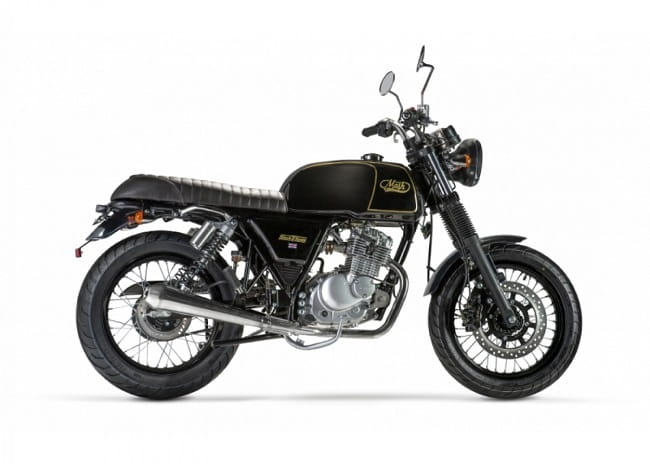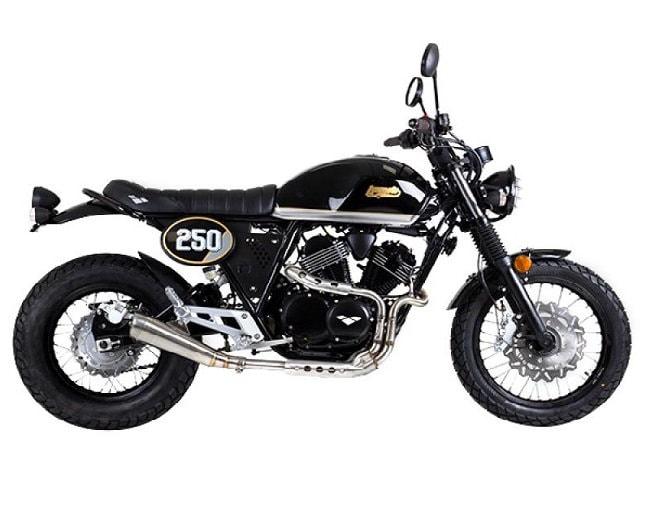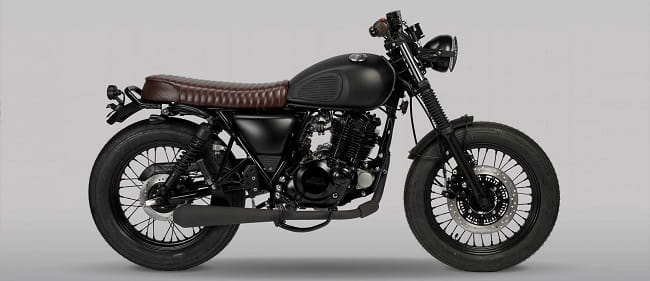‘What are you doing on that thing? It’s a farmer’s bike.’
I’m hot, confused and barely understanding what’s being said. At about halfway up the east coast of Vietnam and hours in the saddle, all I want is a coffee, bottled water and a nod in the right direction.
The lads pointed at my bike, spit, tap ash and continue their roasting.
I thought my basic, modded, cheap-but-reliable, brat-tracker looked cooler than their plastic, tiny-wheeled scooters.
Live and learn, I suppose.
Save Money On Your Motorcycle Insurance
- You could pay less than £195*
- Compare quotes from 25+ UK providers
- Fill in one form to compare top bike insurers
Background
Chinese motorcycles get a bad rap.
This kind of reputation may be nurtured and overstated, but it can’t be entirely manufactured, right?
Motorcycle companies in North America, Europe and Japan have a horse in the race here. Perpetuating the idea that Chinese bikes are trash helps the old-guard of motorcycling.
It’s probably worth pointing out that though your bike might have a Japanese or German name stamped on the tank, you might be surprised to learn where many of its components are manufactured. Some BMW engines, for example, are manufactured by Kymco Taiwan.
Don’t let this put you off. Kymco makes durable, reliable machines and their KTR model (based on 1970’s enduro designs) is one of the most fun, versatile motorcycles available in the region right off the assembly line.
But, what are the core assumptions that lend Chinese bikes their reputation – and are these assumptions still valid in 2020?
Remember – there was a popular movement in the mid-20th century to discredit ‘low-quality, cheaply-made’ Japanese cars. See how that worked out.
We thought we’d do a quick dive into the history of the market and pick out a few Chinese manufacturers that are well-represented here in the UK.
History
I’ve lived in a number of places in East Asia over the last decade, riding either older (’60-’80s) Japanese imports, the occasional Soviet military vehicle, or newer, no-frills, Chinese/Taiwanese bikes. The only parts I’d insist on were a clutch, gears and full-size wheels.
The move away from geared motorcycles in the region had been underway for some time before I got there. Hence the ‘farmer bike’ comment I’d regularly hear as I passed bemused scooter riders. In the consciousness of the locals only farmers needed geared bikes for pulling up muddy hillsides in first and second.
Then, as they so often do, fashions changed.
Geared, easily customisable 125-250cc options with full-sized wheels became a way for young men and women to declare themselves as ‘motorcyclists’ – not simply scooter riders like grandma and grandpa.
Performance
Best to get this out of the way first – low-displacement bikes built in this region are not made for all-out speed and acceleration.
Expect low BHP numbers relative to displacement. These bikes are tuned low in order to run forever. This might be a turn-off for some people, a challenge for others (more on that later) or just what you are looking for.
A lot of people will write off a bike completely based on its low power output.
We get it. Years of marketing based on brake horsepower, top speeds, zero to sixty in however many seconds has made us beholden to these metrics.
But, some of us just want to ride a classy-looking machine, do all the maintenance ourselves and not obsess over how close our street bike is to the latest track/sports models.
That said, there’s a community of people out there dedicated to modding and upgrading every component on these bikes – squeezing every last bit of performance possible.
China Riders is an excellent forum, full of in-depth information on all of these bikes and how they can be modded and maintained. Its community is responsive and helpful.
A real DIY culture has sprung up here. Because they generally use engine designs from tried and true, decades-old Japanese bikes (often with some modern touches like ABS and electronic fuel injection) there’s no shortage of tutorials on how to maintain, adjust and tinker with your bike.
If this appeals to you (and you’re new to motorcycles), it might make a lot of sense to start out with an affordable, no-frills bike that you can get your hands dirty with – and not be terrified that you’re going to mess up a scientifically-calibrated, tuned-to-within-an-inch-of-its-life machine.
Reliability
This is where Chinese and Taiwanese-made bikes come into their own.
To understand why this is, we need to look at the two-wheeled culture that exists there.
Everybody rides. If you’re too old to balance a bike or a scooter, you’re given a four-wheeled mobility scooter with a sunroof. If you’re disabled and can’t afford a car, there’s no shortage of mechanics who can chop your scooter, add a ramp, platform and extra wheels to get you back on the road.
For years scooters were designed to require minimal maintenance and attention. When fashions changed and low-displacement, geared bikes came back in vogue, they too were designed with these principles in mind.
Oil changes every thousand kilometres, check the tyres, keep an eye on the chain, sprockets and brakes – that’s it!
If there’s one myth we’d like to debunk here, it’s that these bikes are unreliable and prone to breaking down. We can understand the reputation when it comes to low power and a lack of torque, but most bikes made for the searing heat, tropical rainstorms, typhoons and ever-present mud will not let you down on your 30km commute to work.
The ‘Motors For The Masses’ Youtube channel is an excellent resource for reviews, durability tests and buyer’s guides for all these machines.
Brand Focus
The real impetus for getting this article out has been the number of classic-looking, well-built, European-designed, Chinese-machined bikes on the market right now.
There was a time when bikes from China/Taiwan were trying to keep up with the latest trends in fairing design from more established Japanese and European manufacturers.
Unsurprisingly, the results were generally inferior, dated-looking knock-offs. Again, it’s important to state this doesn’t necessarily mean these bikes were unreliable – but my oath they were ugly as sin.
Those days are over. Brands like Mash, Lexmoto and Mutt have realized the demand for retro, 1970’s-inspired, no-frills brat/tracker/scrambler type bikes in Europe and North America and have built bikes that really appeal to the aesthetic sensibilities of the market.
Mash

Mash’s mission appears quite simple. Design bikes that look like 70’s English classics, add some modern touches, have them machined and assembled in China and sell them on the European market at a fraction of the cost of their more expensive competition.
Though this French company has just started making inroads in the UK and Ireland, they’ve been a mainstay for cost-conscious riders in mainland Europe for almost a decade.
The attention to detail, miniaturization of external components and genuinely stunning paint jobs put Mash in a league of their own.
Their range of bikes has a minimalist look that can typically only be achieved with a lot of aftermarket components, time and effort on the part of the owner.
As these bikes have been popular in mainland Europe for quite a while, a lot of the information on them is in either French or German. We’ve saved you the effort of trawling through it with Google Translate at the ready – people are saying good things.
Again UK-based Youtube creators ‘Motors For The Masses’ have a number of videos explaining the features, performance and durability of Mash’s range – recommended viewing.
Read our in-depth Mash motorcycles review.
Lexmoto

As of 2020, Lexmoto is the number one selling Chinese motorcycle brand in the UK. Their focus on affordability and excellent customer service may explain some of this.
Their basic 50cc scooter can be bought new for just over 1000GBP, comes with a two-year warranty and might be the cheapest ‘twist and go’ option out there from a brand with a decent reputation.
What caught our attention was Lexmoto’s entries to the 125cc and 250cc market. Though these bikes are both designed and manufactured in China, the Tempest and Vendetta models have clearly taken some inspiration from classic English scrambler/tracker designs.
This isn’t the fastest 250 on the market by any means, nor does it have the most torque – but a quick search around forums and Youtube will reveal an army of satisfied riders. Read – are lexmoto scooters any good?
The low maintenance and excellent reliability make these a favourite for commuters on a budget. Note you will need an A2 licence to ride this bike.
Mutt

Birmingham based Mutt motorcycles seem keen to avoid mentioning it on their website, but their engines are manufactured in China. We hope we’ve said enough to let this dissuade you from taking a look at their range (the factory that builds their engines also does so for Suzuki).
At this point, it might be best to let Mutt take over with their mission statement –
“The whole ethos behind Mutt is to deliver you a bike that’s easy to ride and maintain, affordable to buy and run, whilst giving you the same feel and sound of a classically styled custom machine.”
Mutt base their engines on the bulletproof Suzuki GN125 and GN250 designs. These bikes have been a mainstay of bike couriers since I was a child. This speaks volumes for their reliability, durability and ease of maintenance.
The levels of Steve McQueen era cool here are off the charts. The fact that the company is entirely UK based means the customer service and support are also first rate.
Read our full Mutt Motorcycles review.
Conclusion
This piece is in no way intended to cast shade on the more established Japanese, European and American motorcycle manufacturers. These companies have worked for decades to establish their reputations.
But, if you’re a cost-conscious, new rider, or a veteran looking for a classic-looking, low displacement commuter – some of these brands might be worth a look.
We’re not all looking to get our knees down on corners at top speed. Some of us just want to get around – and do so on something that looks right and won’t break the bank.

